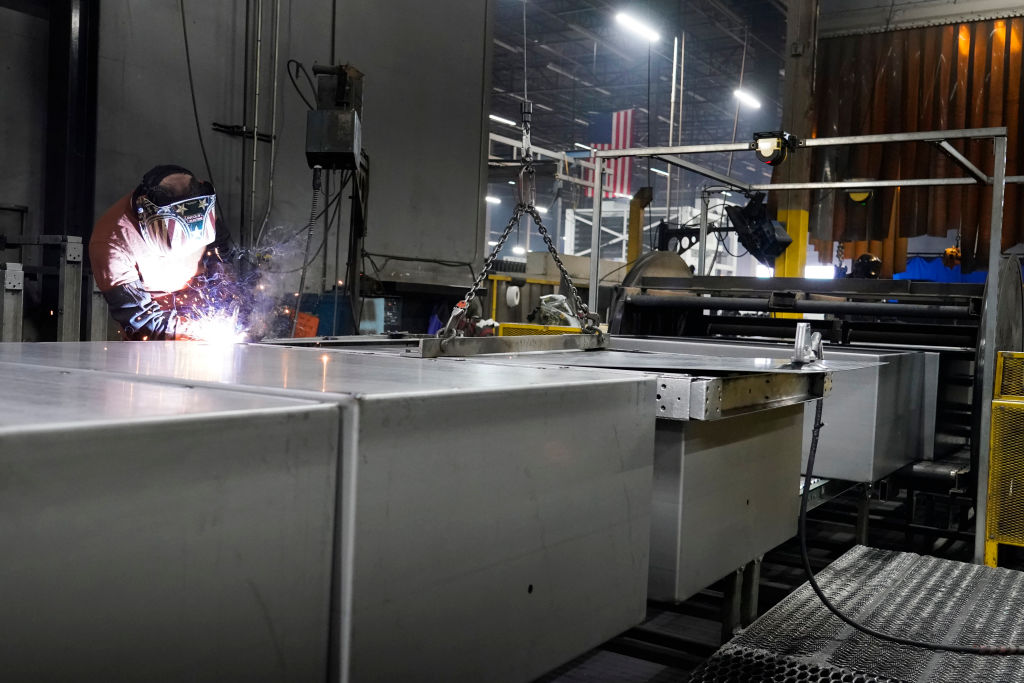Articles about the future and “progress” have been popping up a lot lately, with conversations revolving around the inevitable advancements in technology and automation. Where we should head next is the collective theme. To the metaverse? To outer space itself? But instead of setting our sights on colonizing Mars or creating a perfect alternate reality, we should slow our roll, focus on the here and now and consider whether the frenzied “progress” we’re in such a rush to make has demonstrated any benefit to real-life people.
Manufacturing is a good place to start. Let this startling reality sink in, reported in 2017 by the Organization for Economic Co-operation and Development:
Between 2000 and 2010, US manufacturing experienced a nightmare. The number of manufacturing jobs in the United States, which had been relatively stable at 17 million since 1965, declined by one third in that decade, falling by 5.8 million to below 12 million in 2010 (returning to just 12.3 million in 2016).
This economic disruption has resulted in growing social disruption. While most people in the US assumed the nation was becoming one big middle class, instead a working class facing declining incomes came into clear, angry view during the 2016 US presidential election. The median income of men without a secondary school diploma fell by 20 percent between 1990 and 2013; for men with secondary school diplomas or some college, median income fell by 13 percent. The decline of US manufacturing — traditionally a route to the middle class — hit these groups particularly hard. There is now a major income inequality problem.
I spoke recently to Charlie Paglee, CEO and founder of American Bantam, an old car company Paglee has helped revive. It is his company’s aim to bring manufacturing back to the US, keeping the use of robots in Bantam’s plant to a minimum. Doing so, Paglee says, is critical to America’s independence and survival:
We as a nation must make a conscious decision to bring tooling and manufacturing skills back to the US and grow these industries [here]. We need to create schools to teach people how to operate CNC machines and turn out CNC operators by the thousands. If we don’t do this now, we will lose the expertise in the US and we will literally have to hire Chinese people to come to the US and teach us the skills that we taught China twenty-five years ago.
Corporations and businessmen in the US made a conscious decision to abandon the US and go to China to build things. They invested a lot of money to accomplish this goal. And until Xi Jinping came into power, that seemed like a good thing. China and the US had friendly relations. China was opening up to the world. But now the US dependence on China is an issue of national security. And wages in China are increasing to the point that things can literally be manufactured in the US for less money, if you factor in all the extra costs involved with doing business overseas.
Providing citizens with tangible, meaningful work is vital to a thriving society. Much is made of the benefits of automation and outsourcing jobs, but the costs are ignored. There’s a high-minded and foolhardy theory that posits: in the absence of manual labor, people will be free to pursue “better” work. But how likely is it that we all have the talent or desire to become watercolor painters, novelists, and master tapestry-weavers? It’s a myth that as machines take over people’s jobs or they’re done by people in other countries, Americans will elevate themselves to something “nobler” and more worthwhile.
Millions of American jobs disappeared a decade ago and millions more continue to be outsourced. Some to robots, many to Mexico, China and elsewhere. And guess what? Bill in the Rust Belt didn’t say, “Oh well, I’m laid-off. I guess I’ll pursue my true calling of being a medieval-style harpist.” No. Bill went home and drank beer. And got depressed. And lost his house. And his wife divorced him. And he grew more depressed. And started taking pills. And got hooked. And…you know the rest.
“If you’re not progressing, you’re regressing; so, keep moving forward,” proclaimed Elon Musk (who also named his latest child “X Æ A-Xii” — never forget that). But perpetual motion, if you don’t have a destination, is dangerous. Is “progress” for progress’s sake — to be the first, the fastest, the most automated, etc. — really an improvement for the people who are supposed to profit? Or, as Peter Thiel puts it, are the advancements we’re making in the digital world mere distractions?
Laying off the Bills of the world in favor of cheaper goods from China is not “progress.” Neither is replacing blue-collar workers with robots and foreign laborers. This makes our country weak, dependent and vulnerable. Of course we want to remain competitive in the global market and relevant in the technological world, but we must be smart about it. In replacing people, we forget people were ever involved, that people were affected, and that people are the whole point. To adapt a quotation from The Forsyte Saga, “What are we progressing for?” Evidence shows the “progress” we’ve made in the last ten years has eroded our middle class and escalated mindless materialism and misery, so are we really better off?
Are we beyond useful technology? Whatever we’re doing, it’s not working, as depression, anxiety and loneliness are through the roof, and our economic and social gap keeps widening. People need something to do that gives them purpose and satisfaction. Our nation can’t afford to lose these skills either, and relying on other countries with historically insane leaders, as we’ve seen most recently with Russia, and automated machines that break down and then need parts from foreign countries, as we’ve seen with the supply chain crisis, is a bad idea.
To bring manufacturing roaring back, Paglee says,
We need to incentivize manufacturing in the US with seed capital or low-interest loans paid back with tax income. This is what the Chinese do. It would be incredibly effective to study what the Chinese do from an economic development standpoint and copy what is effective. We also need to re-examine the commerce clause, or just get Congress to pass legislation absolving small businesses from federal regulation to lower the cost of doing business. If we don’t cut the red tape the US will not be a competitive place to manufacture goods. All those federal regulations may be nice, but require a business to be fully insured and let the insurance marketplace take care of regulating industry safety.
Sounds like a 2024 presidential campaign platform to me.

























